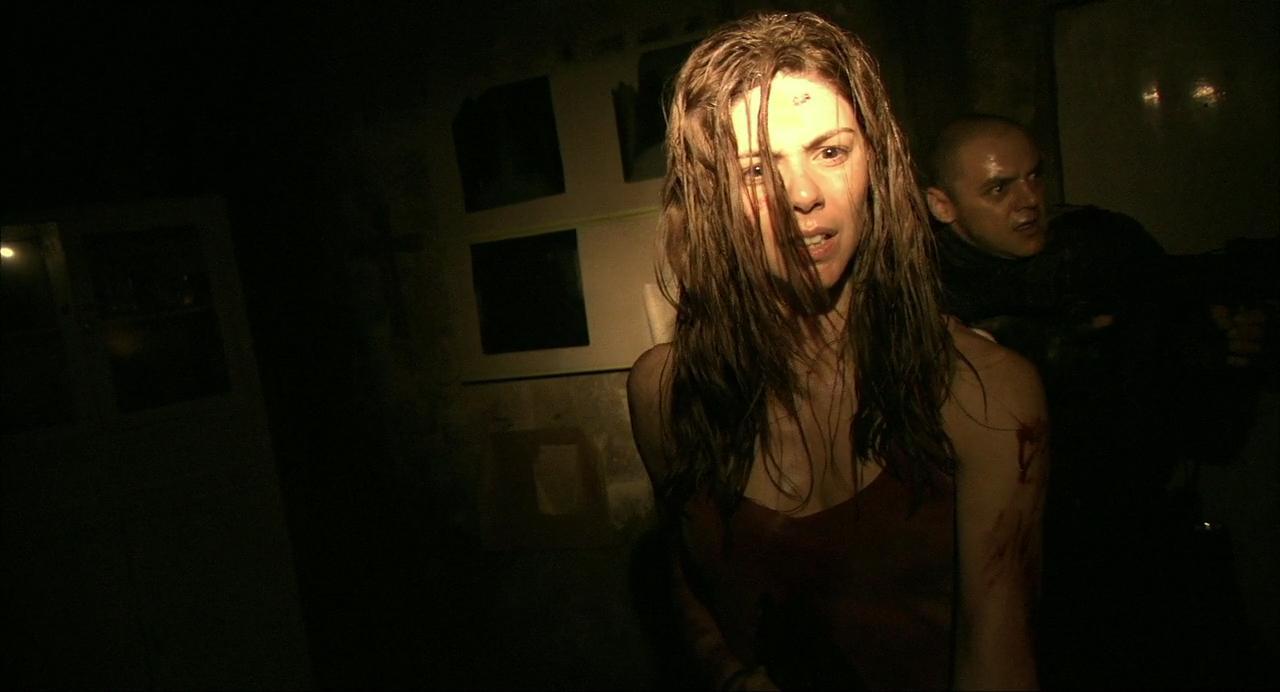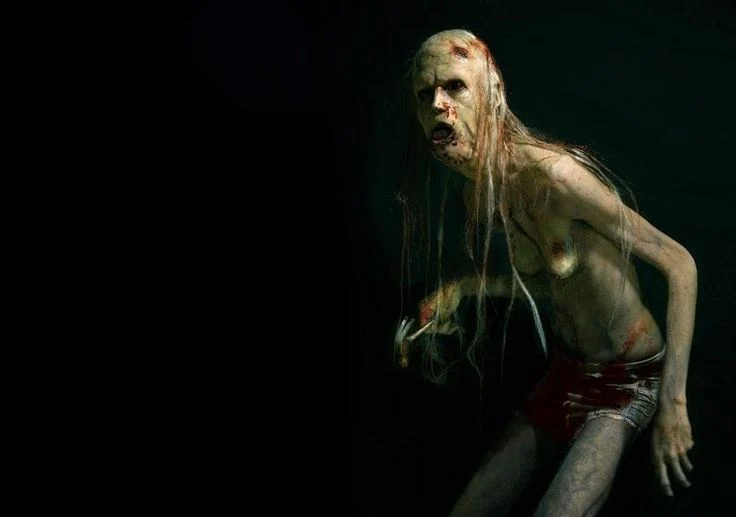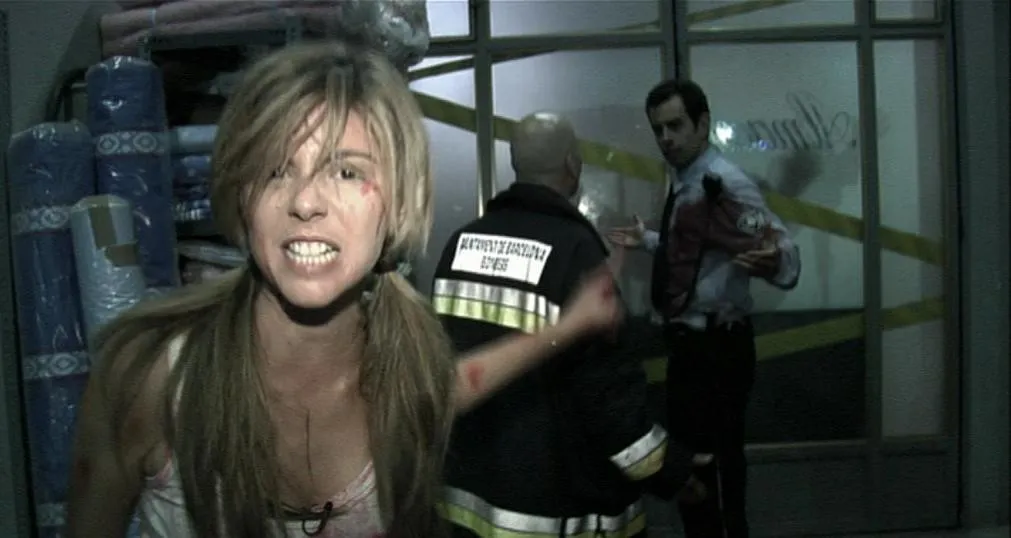Rec is a 2007 Spanish-found footage horror film co-written and directed by Jaume Balagueró and Paco Plaza. It was released at the height of the Found Footage craze. Since 1999’s Blair Witch Project, it’s been assumed that if a film isn’t shot in found footage, it isn’t a horror film.
Even back then, the picture managed to stand out, gaining international acclaim, spawning a series of sequels, and the inevitable, inferior American remake. In the film, a reporter and her cameraman follow a fire fighting unit on an emergency call at an apartment complex. After an infection rapidly spreads inside the facility, the situation soon worsens, with the building being sealed up while its people are required to follow a rigorous quarantine.
Both commercially and critically, the picture was a smash hit. In present times, this is regarded as one of the genre’s early triumphs, as well as one of the best. Rec was ranked number 60 in Time Out’s list of the top 100 best horror films of all time. In fact, REC’s avalanche of horrors moved at lightning speed, giving viewers little time to catch their breath.
More impressively, Balagueró and Plaza saved the best for last, concluding their documentary with such a stunning scene that it became instantly famous. Today we’re taking a look at this terrifying horror movie that is bound to leave you terrified.
Whatever You Witness….. Never Stop Recording – REC (2007)

The story revolves around Angela, a TV reporter, and Pablo, her cameraman, as they follow a group of local firefighters. Angela’s face appears bored during the interviews; she is clearly disappointed in their assignment and impatient for anything to happen; she keeps hoping the alarm will go off. Of course, it happens, and she and Pablo, along with Fireman Manu, race to an apartment building.
Initially, the directors considered having a TV camera team that follows certain police officers. They chose firemen instead because they are more popular and accepted by the general population, especially in the aftermath of 9/11.This film was shot in the Cedimatexsa building, Rambla de Catalunya, 34 in Barcelona’s Eixamplearea. After the film’s success, it was attacked by a mob of teenagers in 2007.
The apartment saw thousands of tourists and fans gather around what had now become a cinematic monument. All the locations are real and no sets were made. In fact, to make it all even more real, when it came to casting, the directors purposefully chose unknown individuals to help make the play more genuine, as well as performers who were adept at improvisation.
When they arrive, all of the occupants are gathered on the stairs, confused about what’s going on and agitated by shouts from one of their neighbors. An elderly woman in one apartment appears to have gone insane, becoming violently hostile and attacking a police officer, prompting Angela and the others to flee.
As they return to the bottom floor, they discover that the health department has sealed the entrances and quarantined the building, keeping everyone within with an unknown infection. The military arrives and it’s clear that what was happening to them was definitely not a common incident.
Alex, who remained upstairs with the old woman, is thrown over the staircase railings and seriously injured as people begin to panic. Mrs. Izquierdo then murders a girl, forcing the surviving cop, Sergio, to shoot her. What follows is a frenetic scene in which the contained video crew, civil workers, and building attendants gradually realize that they are stuck in the building with deranged, most likely infected lunatics.
When they bite, the infection spreads, and the remaining few have to deal with additional infections. It’s a standard zombie situation, but this time it’s confined to three flights of tiny staircases and dark apartments. The photographer sprints around, shaking the camera and using it to protect his face during attacks. When an infected resident strikes the microphone or the camera is dropped entirely, the sound pings out, and we’re left watching from an angle that shows us close to nothing.
Angela and Pablo then begin their interviews with the residents. Jennifer, a sickly small child, is one of the interviewers. Her mother, Mari Carmen, claims she has tonsillitis and that her dog, Max, is also sick and is being treated at the vet. A hazmat suit-clad health inspector arrives and attempts to care for the injured and treat them until they become unusually violent.
After locking the injured in the building’s textile warehouse, the health inspector reveals that they are sick with a virus comparable to rabies and that the disease was traced back to a dog in the apartment complex, and Angela understands it must be Max. As this realization comes to light and they start questioning both Jennifer and her mother, things take a drastic turn. All of a sudden Jennifer turns bites her mother’s face and flees upstairs when the residents confront Mari Carmen.
Sergio binds Mari Carmen to the steps and follows Manu and Pablo upstairs. They locate Jennifer, but she bites Sergio, who orders the others to leave him alone. Manu and Pablo discover the surviving occupants fleeing upstairs after the infected in the warehouse had smashed the door. The rest of the apartment’s tenants are gradually bitten and infected, leaving almost all of the residents in a murderous, zombie-like state.
The remaining party searches for a key that will open a basement entrance, allowing them to escape the quarantine undetected. However, in the process of getting there, the number of survivors reduces to three: Angela, Pablo, and Manu. When Manu is bitten and infected, and their way downstairs is blocked by a swarm of ravenous tenants, Angela and Pablo take refuge in the only place remaining — the empty, ominous penthouse. If things weren’t already bleak, things are about to get a hundred times worst.
They discover news clippings on the walls and a tape recording that reveals the penthouse owner to be a Vatican agent. Tristana Medeiros, a demonically possessed girl, charged him with isolating her with an infected enzyme.
During the treatment of Tristana, the enzyme altered and became infectious instead. The Vatican agent then shut off Tristana’s penthouse and left her to die. In fact, this is credited with being one of the primary influences on the first-person survival horror game Outlast (2013). The game investigates the boundaries between science and religion in the same way as the “REC” series does with medical science, viruses, and possession. The game’s POV was also influenced by the shaky-found film aesthetic employed in “REC.”
As they explore the bizarre material in the penthouse, the attic door swings down as the cause of the disease is revealed. Pablo investigates with the camera, but an infected child knocks it to the floor, breaking the camera’s light in the process. It leaves Angela and Pablo in full darkness until Pablo discovers the camera’s night-vision setting. Pablo notices a now very malnourished Tristana roaming around the room, hunting for food, while attempting to soothe a scared Angela.
As the gaunt Tristana knocks around the place, he whispers to Angela to be quiet. Pablo tries to steer them away from Tristana, but they run into something that alerts her of their presence. Tristana assaults Pablo, pummelling him to death and causing damage to the camera. It lands on the floor, capturing a terrified Angela as she fumbles around on the floor, blindly looking for safety. When she sees Tristanaleaning over Pablo’s body, she drops the camera again. The camera is then pointed at Angela as she belly-crawls toward it, only to be taken away into the darkness.
The final shot of our protagonist being dragged away into the darkness creates an indelible memory. It’s both a final scare and a fitting finale rolled into one. The filmmakers save explanations regarding the epidemic until the conclusion, which enhances the emotional response to Tristana’s arrival.
With Angela trapped in a position with no way out, this finale makes the most logical sense. That, however, doesn’t make the abruptness any less shocking.REC has one of the most amazing payoffs in horror. On a narrative level, it neatly wraps things up while keeping the film’s severe, nihilistic tone.
Visually, the excellent staging ensures that Tristana’s quick on-screen appearance does the most shock-induced damage imaginable. Above all, with the use of recovered film, Balagueró and Plaza immerse the audience in this terrifying experience. REC is the apex of found footage horror because it manipulates two key film tools, sight, and sound, to instill anxiety and fear in the audience.
Demonic Enzyme – Virus that Affects the Human Mind Explained

As the action unravels, things look more and more like a zombie infection. I mean, it only makes sense that there is a virus going around that is passed on through biting others which makes them go into a ravenous frenzy.
However, this was not the case. Turns out that the cause behind the disaster was actually a demonic enzyme that the Vatican had discovered and then entrusted a priest to treat it. Why they didn’t think it was a good idea to take it to a doctor or a pathologist is beyond me but we’ll take that in our stride. The virus began spreading mostly because of the infected biting the others but blood, saliva and all kinds of bodily fluids were also contagious.
We realize midway that a dog named Max was probably the first carrier of this mutagenic disease and the most probable way of that happening was through rats and mice that infest the building who carried the infection from the pent-house all the way to Max.
The Vatican priest was also experimenting on the rats and mice with the virus. This also pointed to the first human to be infected being a little girl named Jennifer who was Max’s owner. This brought up a new fact about the virus which was that reaction times post-infection were not the same for everyone. If an infected person bites someone, the time of the reaction varies on the victim’s blood type, which apparently has something to do with a body’s innate immunity.
The approximate time of reaction in children is longer than that in any diseased adult. Jennifer only suffered symptoms like tonsillitis, according to her mother. We also learn that the virus can also traverse species boundaries. Jennifer’s dog was infected in the first film and caused havoc in a veterinary facility.
This points to the fact that the virus might be a mammalian virus instead of just a human virus. In fact, if one takes into account all the symptoms that people were exhibiting along with how the disease was passed on, it seems like what had actually overtaken this little housing community was a mutated and the worse form of rabies. However, the filmmakers had other things in mind, thus adding a supernatural angle to it.
The victim also slips into a temporary coma after being bitten or infected while having convulsions and excessive salivation or foamy saliva, similar to a rabies virus. The eyes of the infected are usually blood red or blank white.
The infected move swiftly and have little regard for self-preservation, seeking only to spread the illness, and are thus nearly unstoppable without destroying the brain. Because the virus is demonic in origin, it can be kept away using Christian exorcism prayers and religious paraphernalia such as crosses and holy water.
With all of this in mind, it makes the most sense to assume that the demonic enzyme was in fact just a terrible, mutating and contagious virus that would turn people into violent, mindless zombies which is most likely to be a mutated form of rabies. If it did in fact have something to do with the supernatural, we may never know.
Movies that have come after it and the Hollywood remake have mostly tried to do away with the ‘demonic’ aspect of it and treat it like a virus that seems to be more rational and believable. However, for this movie, suspend your disbelief and accept the story of its demonic origins because it will definitely make it scarier.
Tristana Medeiros – Possessed Zombie

Tristana Medeiros, known as La Nia Medeiros in Spanish, is one of the REC series’ two main antagonists. She made her debut in this film and had a larger role in REC 2 than in Genesis (REC 3). However, the story behind this demonic entity is actually quite a tragic one. Tristana Medeiros was a Portuguese girl who resided in a convent and worked as a cook, before turning into the terrifying monster that we know.
Tristana was sexually abused by a gang of priests one night and discovered dead by a nun the next morning. During her vigil, Tristana awoke, reacting angrily to the priest’s religious prayers and being bound with ropes on her bed by the nuns. The girl glanced one more time at the inverted cross above her and then closed her eyes, displaying the first signs of demonic possession immediately after opening them.
The devil inside Tristana killed the nuns and the priest was then slain by being beaten on the head with the cross. The nun who found Tristana after the rape managed to calm her down by inserting a sedative into her neck. Tristana, who was possessed, was held under control with injections and bound to a crucifix until the Vatican priests come, one of which being Father Alberta. The case made news, and Tristana was reported missing a short while later.
Alberta managed to transport Medeiros to a pension building in Barcelona, where the devil was imprisoned in the attic. Alberta, in addition to being a pious man, conducted scientific experiments using Medeiros’ blood, using rats and surrounding youngsters as guinea pigs. The studies found that the possession functioned as an infectious sickness, akin to influenza and Alberta then concluded that he needed to kill the possessed girl, who had transformed into a horrifying creature, in order to prevent a possible contagion.
Alberta poisoned Medeiros’ food, which was made out of body parts, and served it to her. However, she clearly does not die and instead pursues the priest. He is compelled to climb into the air ducts and lock himself inside to die. Medeirosthen began living in the apartment, supernaturally confined in the darkness, until a young woman named Angela Vidal entered the room looking for a place to hide. This unleashed her upon mankind once again and if you want to see more of her (although I don’t know why one would), then you should also check out the sequels of this movie.
Why should you watch Rec?

Rec organizes the plot in such a way that zones of risk and relief may be practically linked to the structure of the building. The video becomes increasingly claustrophobic and outrageously chaotic as the plot develops, with residents turning on each other in their panic.
However, rather than being a jumbled mess, Rec stays a thrilling trip from start to finish. It does such a superb job of establishing plot strands and the actual locations of persons and spaces that even with the camera bouncing blurrily from side to side, what is happening is crystal clear. This is a massive plus point with regards to the movie and draws the viewer into this tense environment.
Rec’s hallmark technique is to position the viewer firmly in the heart of the action, which directors JaumeBalagueró and Paco Plaza have stated they intended to do so that the picture feels like it was happening live. The audience is transported through the scenario, whether willingly or unwillingly, as seen via Pablo’s eyes, or rather his camera, making the whole thing feel like the scariest theme park ride you’ve ever been on.
The ending, in true found-footage movie fashion, does not satisfy on any emotional level, but it doesn’t need to because it has done such an excellent job scaring the bejesus out of us. That enthusiasm helps moviegoers to overlook any problems in the film’s non-existent character creation and be immersed in a horrific setting expertly produced. This movie is high on our must-watch list so definitely check it out. It is hands down one of the best movies in the found footage genre and I doubt we will see something of this caliber come out of this genre ever again.
